|
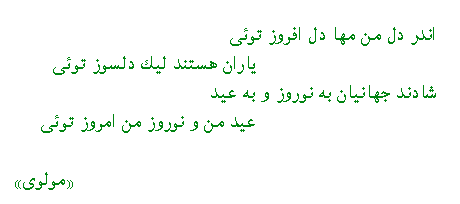 |
Noruz (Iranian new year):
(from http://www.farsinet.com/norooz/haftsinn1.html )
|
 |
Sofre-ye Haft-Sin
A few days prior to the New Year, a special cover is spread on to
the Persian carpet or on a table in every Persian household. This
ceremonial table is
called cloth of seven dishes, (each one beginning with the
Persian letter cinn). The number seven has been sacred in Iran
since the ancient times, and
the seven dishes stand for the seven angelic heralds of
life-rebirth, health, happiness, prosperity, joy, patience, and
beauty.
The symbolic dishes consist of:
The
Spread of The Seven "S"'s 1.Sabzeh or sprouts, usually wheat or lentil representing rebirth. 2.Samanu is a
pudding in which common wheat sprouts are transformed 3.Sib means apple and represents health and beauty. 4.Senjed the
sweet, dry fruit of the Lotus tree, represents love. 5.Sir which is garlic in Persian, represents medicine. 6.Somaq sumac
berries, represent the color of sunrise; 7.Serkeh or vinegar, represents age and patience. |
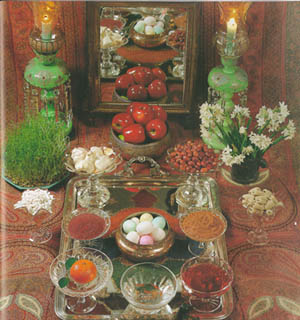 |
Other elements can include:
a few coins placed on the sofreh represent prosperity and wealth;
a basket of painted eggs represents fertility;
a Seville orange floating in a bowl of water represents the earth
floating in space;
a goldfish in a bowl represents life and the end of astral
year-picas;
a flask of rose water known for its magical cleansing power, is
also included on the tablecloth;
Nearby is a brazier for burning wild rue ,a sacred herb whose
smoldering fumes ward off evil spirits;
A pot of flowering hyacinth or narcissus is also set on the
sofreh;
A mirror which represents the images and reflections of Creation
as we celebrate anew the ancient Persian traditions and beliefs
that creation
took place on the first day of spring.
On either side of the mirror are two candlesticks holding a
flickering candle for each child in the family. The candles
represent enlightenment
and happiness;
images of noruz:
Idealized, 19th century (Qajar) pictures:
 |
Prayer said during the Haftsin:
ya muqallib al-qulub wa
'l-ahwal
hawwil halina ila ahsan 'l-hal
"O you,
transformer of hearts and spiritual states
make our states the loveliest of states."
Other elements:
Haji Firuz (Persian Santa
Claus?): Troubadours, referred to as Haji Firuz, disguise
themselves with makeup and wear brightly colored outfits of
satin.
These Haji Firuz, singing and dancing, parade as a carnival
through the streets with tambourines, kettle drums, and trumpets
to spread good cheer and
the news of the coming new year.
 |
Chahar-shanbeh Suri: leaping over the flames
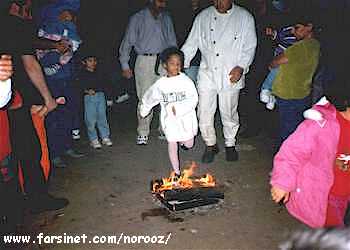 |
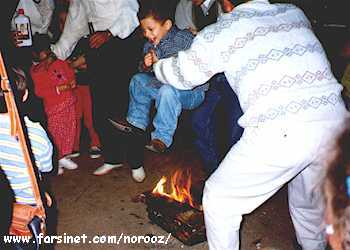 |
Sizdah bedar: "getting rid of the
13"
The two weeks long NoRooz celebration ends with SeezDeh Bedar.
SeezDeh means Thirteen and SeezDeh Bedar is the process of
getting over with or
passing over the thirteenth day of the New Year.
This tradition is called Seezdah Bedar (seezdah means thirteen)
which in English translates to "getting rid of
thirteen". This fun and exciting outing
involves all family members and is intended to end the holiday
season on a relaxing and positive note. The concept of avoiding
the number thirteen is
mainly to symbolize the will and power to deal with all evil in
the new year.
An interesting ritual performed at the end of the picnic day is
to throw away the Sabzee from the Nowrooz Haft Seen table. The
sabzee is supposed to
have collected all the sickness, pain and ill fate hiding on the
path of the family throughout the coming year! Touching someone
else's sabzee on this
thirteenth day or bringing it home is therefore not a good idea
and may result in absorbing their pain and hardship.
A picture of the sprouting green (sabzeh) grown around this time:
 |
Another meaningful ritual performed with the dumping of the
sabzee is that young single women tie the sabzee leave(s) prior
to discarding it,
symbolizing the wish to be tied in a marriage by the Seezdah
Bedar of next year! The young ladies are often heard whispering
the following rhyme
while tying the leaves:
"Sal-e deegar, khune-yeh showhar,
bacheh baghal!"
This translates to: "Next year, in the husband's house, with
a baby in arms!"
Newly weds also tie a grass knot making wishes for a baby, a house, or whatever is on their Have-To-Have list.
Noruz cards, as a chance to express cultural, national, and/or religious identity:
(the three, from left to right, foucs more on religious imagery,
idealistic nature imagery, and pre-Islamic nationalist heritage)
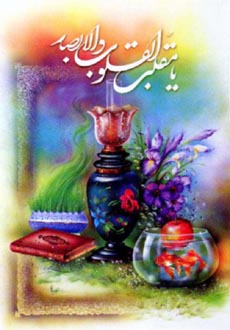 |
 |
 |